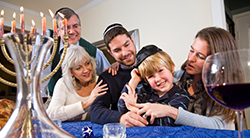 Before setting off on a hike in the mountains of Montana, Rabbi Lawrence Kushner was unsettled by all the signs warning about bears. He peppered the National Park Service employee with questions about which trails might be bear-free. Eventually, he got this response: “If I could tell you for sure there wouldn’t be any bears, it wouldn’t be a wilderness now would it?”1
Before setting off on a hike in the mountains of Montana, Rabbi Lawrence Kushner was unsettled by all the signs warning about bears. He peppered the National Park Service employee with questions about which trails might be bear-free. Eventually, he got this response: “If I could tell you for sure there wouldn’t be any bears, it wouldn’t be a wilderness now would it?”1
Over the course of the Book of Numbers, the Israelites may not have encountered bears, but they have been overstuffed with quail, bitten by snakes, swallowed by the earth, and struck by plagues. They have been counted and recounted, and between these two censuses an entire generation has died out. Miriam and Aaron have died, and Moses’ death has been foretold. They have swung between fear and faith, and have taken comfort in complaining. Despite all this, or perhaps because of it, by the end of the book they are beginning to coalesce.
Three instances in the combined portions, Matot/Mas-ei, bring this coalescence to the fore. First, we have the request of the tribes of Reuben and Gad to settle in Transjordan, where the land is good for their cattle, rather than claim their tribal portions in the Promised Land (Numbers 32). One can only imagine the personal pain Moses may have felt at this request. He has been denied the fulfillment of crossing the Jordan, and here these tribes are, spurning the opportunity of which he dreamed. On a communal level, he sees this request as a threat to the whole enterprise of the journey through the desert. Just as the scouts kept one generation from entering the Land, he fears that this action will endanger the next: “If you turn away from [God], who then abandons them [the people] once more in the wilderness, you will bring calamity upon all this people” (Numbers 32:15). However, instead of a violent confrontation, this situation leads to compromise: Reubenite and Gadite warriors will fight beside the other tribes in the conquest of Canaan, and only then will they return to their families and their holdings. They recognize their obligation to the people as a whole beyond their individual interests.
Second, among the rules given in these final chapters, we find the provision for cities of refuge: places where a person who kills someone unintentionally could be protected from the vengeance of the family of the deceased (Numbers 35:9-34). One of the oddities of this provision is that the residents of these cities can only leave them upon the death of the High Priest. This leads to the strange situation, recounted in the Mishnah, that the mother of the High Priest would provide food and clothing to those who lived there, to keep them from praying for her son’s death (Mishnah Makot 2:6). But why should the death of the High Priest lead to the manslayers’ freedom? Abarbanel (Italian, 15th century) has one intriguing theory:
Because the high priest was such a great man and holy to his God, the whole community would take his death to heart, and realize that “man is like a breath; his days are like a passing shadow” (Ps. 144:4). The blood-avenger too would realize that one day he too would be brought to the grave like any other, and he would be reconciled to his relative’s death and forget his obsession with killing the manslayer. (Abarbanel on Numbers 35:25)
In other words, the death of the High Priest would consume all the people with communal mourning and remind them of their own mortality. With this perspective, the bereaved family members might let go of their own desire for vengeance. Here too, we see a recognition of the power of peoplehood and seeing beyond the self.
Finally, we have a revisiting of the case of the daughters of Zelophehad. Previously, they won the right to inherit from their father (Numbers 27:1-11); here, their marriage prospects are limited to keep their holdings within their tribe (Numbers 36:1-12). Just as God deems their original plea to be correct, here too, God affirms the concerns of their tribe. From the point of view of individuals asserting their rights, this revised judgment is a setback. From the point of view of a people balancing competing claims, we see a parallel to the treatment of Reuben and Gad’s request. Nobody gets exactly what they want, but everyone gets what they need.
All of this is in the context of the end of the book, and the listing of the Israelites’ journeys. Of the many midrashim explaining this long list, covering 42 places, one central theme emerges: the relationship between God and God’s people. Here too, the message is that in good times and bad, we are never alone:
It is like the case of a king whose son was ill. He took him to a certain place to cure him. On their return journey his father began to recount all the stages, saying: “Here we slept; here we cooled ourselves; here you had a headache.” So the Blessed Holy One said to Moses: “Recount to them all the places where they provoked me. (B’midbar Rabbah 23:3)
Even in reproof, there is relationship.
At the end of his reflection on the Montana mountains, Rabbi Kushner writes: “Without the wilderness, there can be neither reverence nor revelation.”2 I would add: Without the wilderness, there can be no relationship. The experience of these travels set the foundation for God’s relationship with the Israelites, and our relationships with each other, as we prepare for the Promised Land.
1. See Lawrence Kushner, Invisible Lines of Connection [Woodstock, VT: Jewish Lights 1996], p.19)
2. Ibid.

The Book of Numbers concludes with a recounting of the journey of B’nai Yisrael since leaving Egypt and instructions for the subsequent occupation of the Promised Land. As Rabbi Grushcow concludes, the central theme of this narrative is relationship. Every journey is enriched through meaningful relationships, with people, with God, and with tradition.
Recently I had the pleasure of participating with an 80-year-old woman as she finally celebrated becoming a bat mitzvah. Her journey in many ways evokes the messages we read about in Matot-Mas-ei. In her d’var Torah she spoke about her Classical Reform Jewish upbringing in Michigan, and how though she would have loved to celebrate a bat mitzvah when she was 12 or 13, she had to settle for confirmation at 14 instead. Her subsequent journey culminated 67 years later as her daughters presented her with a tallit before she read from the Torah in the presence multiple generations of family and friends, blessed relationships with whom she shared in this blessed simchah.
Not two years prior, during the hakafah on Shabbat morning, she backed away from the Torah, explaining that she felt uncomfortable with this ritual. This “dance” would continue and evolve to the point where instead of leaning in with the Torah for her to touch, I would lean into her and give her a kiss on the cheek, a sign of our developing relationship.
During our preparation for her bat mitzvah, she defined herself as a “secular” Jew. She shared her personal journey, from her liberal Jewish upbringing, through her two marriages to men disengaged from Jewish community and practice, to raising her children. We discussed her charity and volunteer work, her desire to reengage in Jewish life, and the fact that she not only chose to affiliate with our synagogue, but she also made a commitment to finish what she started a lifetime ago.
She finally came to realize that she was far from a secular Jew. She grew up in a Classical Reform synagogue, where she was very engaged in the community, and she found great comfort in early Reform tradition and customs. Confirmation, not b'nai mitzvah (bar/bat mitzvah) celebration was the norm, and though elected by her peers to serve as youth group president, she was relegated to vice president because a girl could not serve in the top role. Though neither husband wished to affiliate with the Jewish community, each one still accompanied her to synagogue for the High Holidays. They celebrated Passover at home complete with a Haggadah that she created herself celebrating the accomplishments of the heroines of the narrative. Her continued tzedakah activities and donations to both Jewish and secular causes, and her eventual return to synagogue engagement, are a testament to her deep-rooted Jewish values, commitment to Jewish life, and her enduring relationship with the Jewish community. Nevertheless, there was a part of her journey that felt incomplete.
At the very next Shabbat following her bat mitzvah celebration, wearing a beautiful tallit that she had purchased in Israel, she gave me a great big smile as she reached out with her tzitzit to touch and kiss the Torah. Her newfound discovery that this symbolic act, at least for her, was about connecting to her heritage and her unrelenting relationship with her community. Her journey had come full circle as she finally realized her dream leading to her own personal Promised Land.
Matot-Mas-ei, Numbers 30:2−36:13
The Torah: A Modern Commentary, pp. 1,215−1,248; Revised Edition, pp. 1,099−1,133
The Torah: A Women’s Commentary, pp. 989–1,036
Second Haftarah of Affliction, Jeremiah 2:4–28; 3:4
The Torah: A Modern Commentary, pp. 1,282–1,286, Revised Edition, pp. 1,135–1,138
